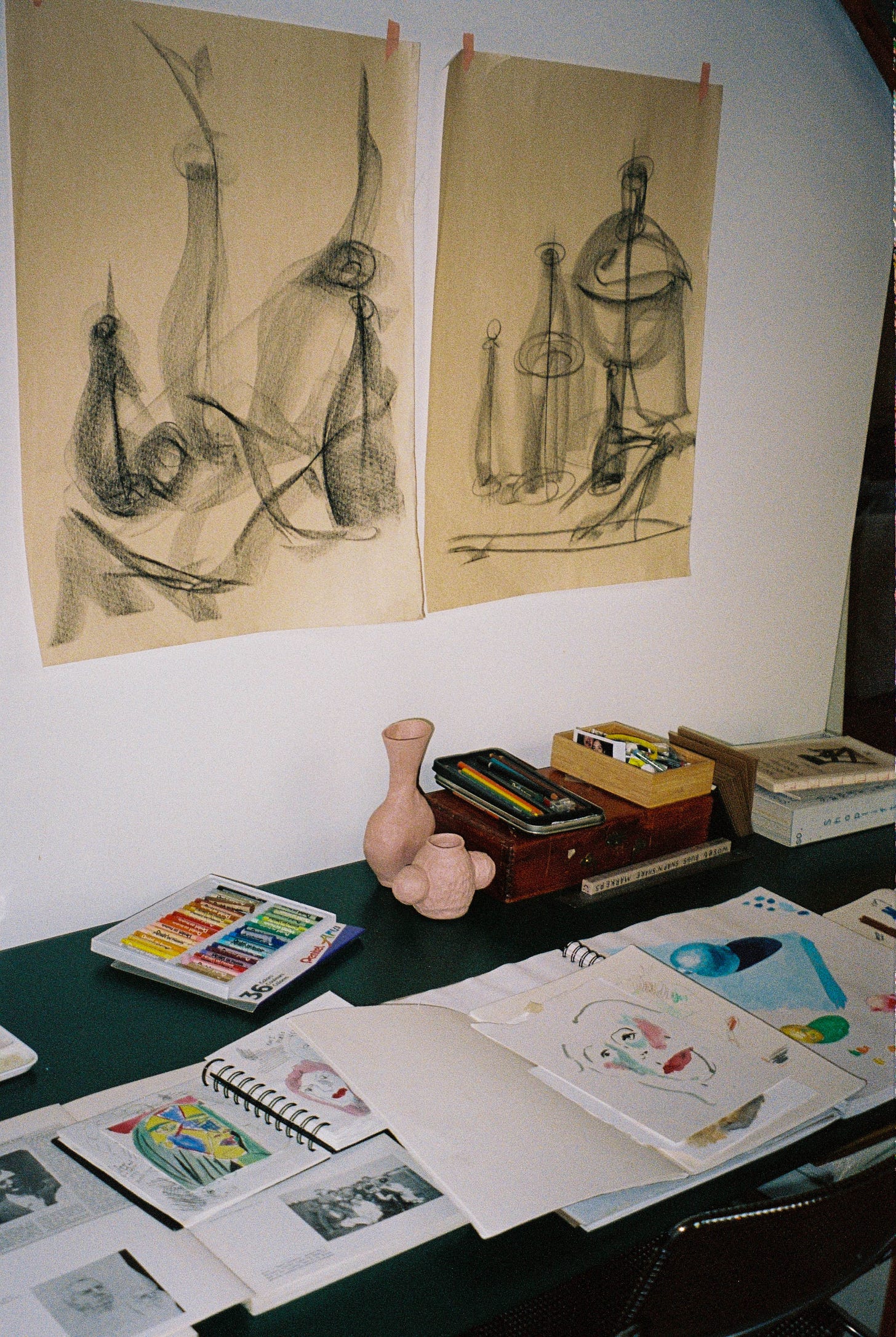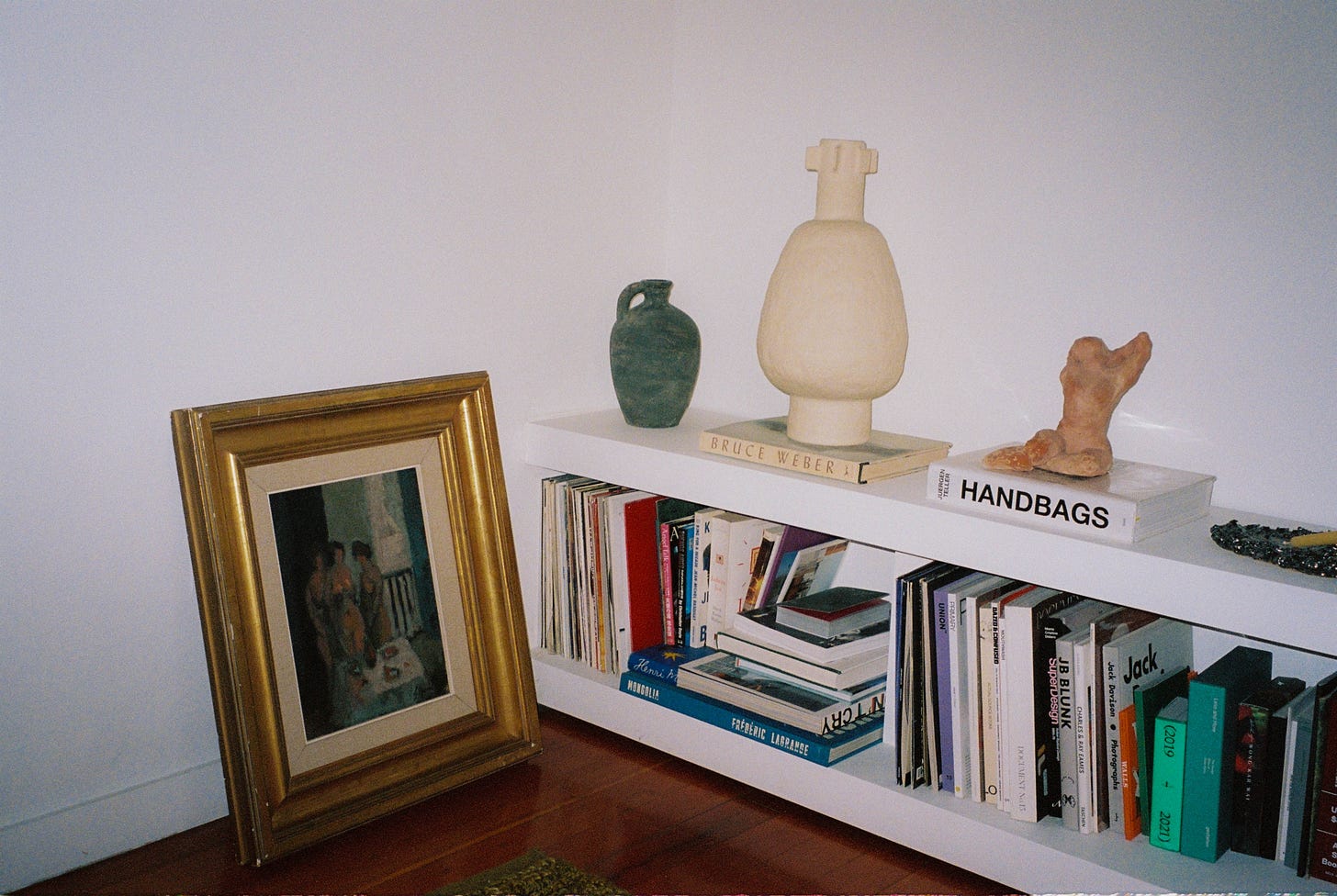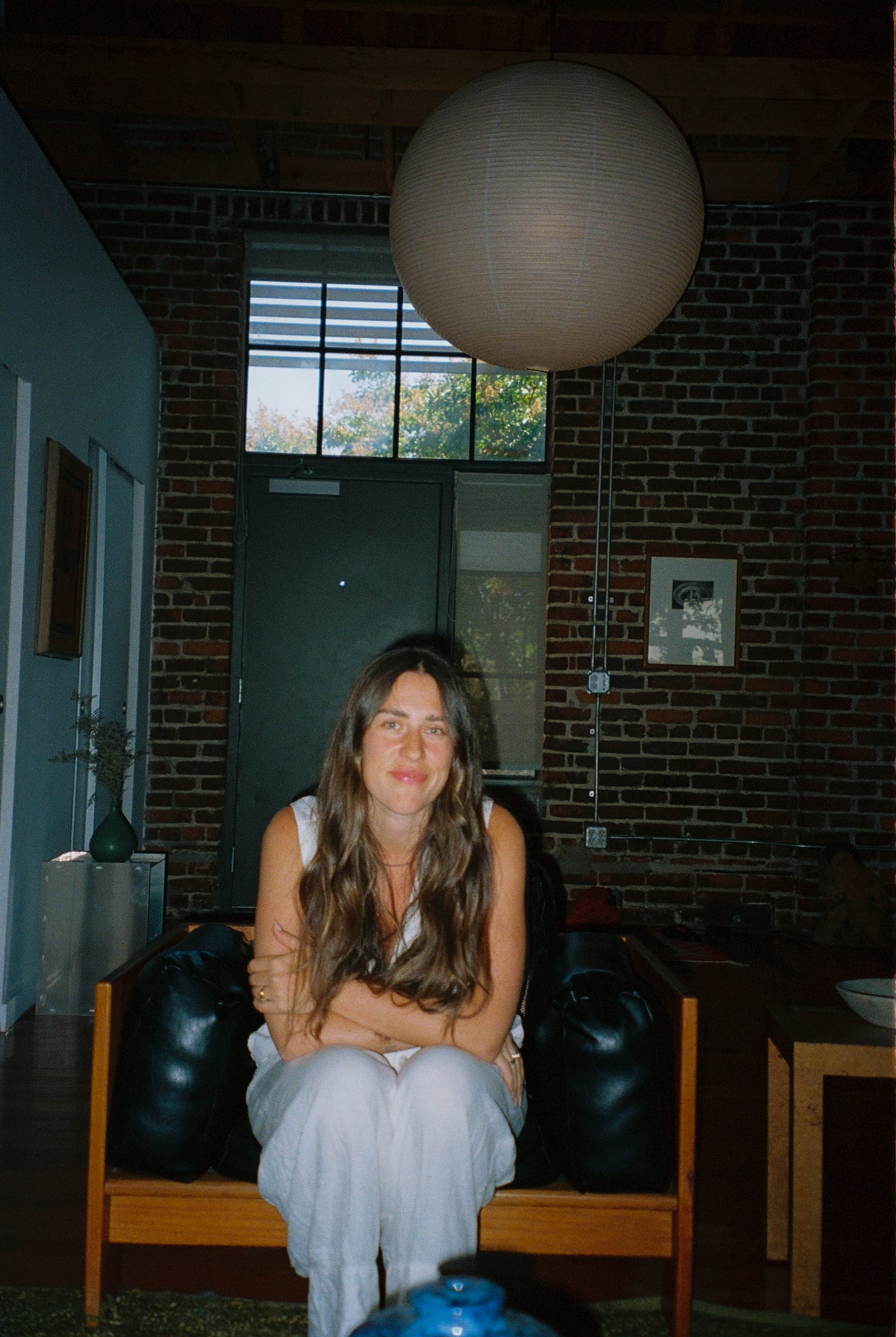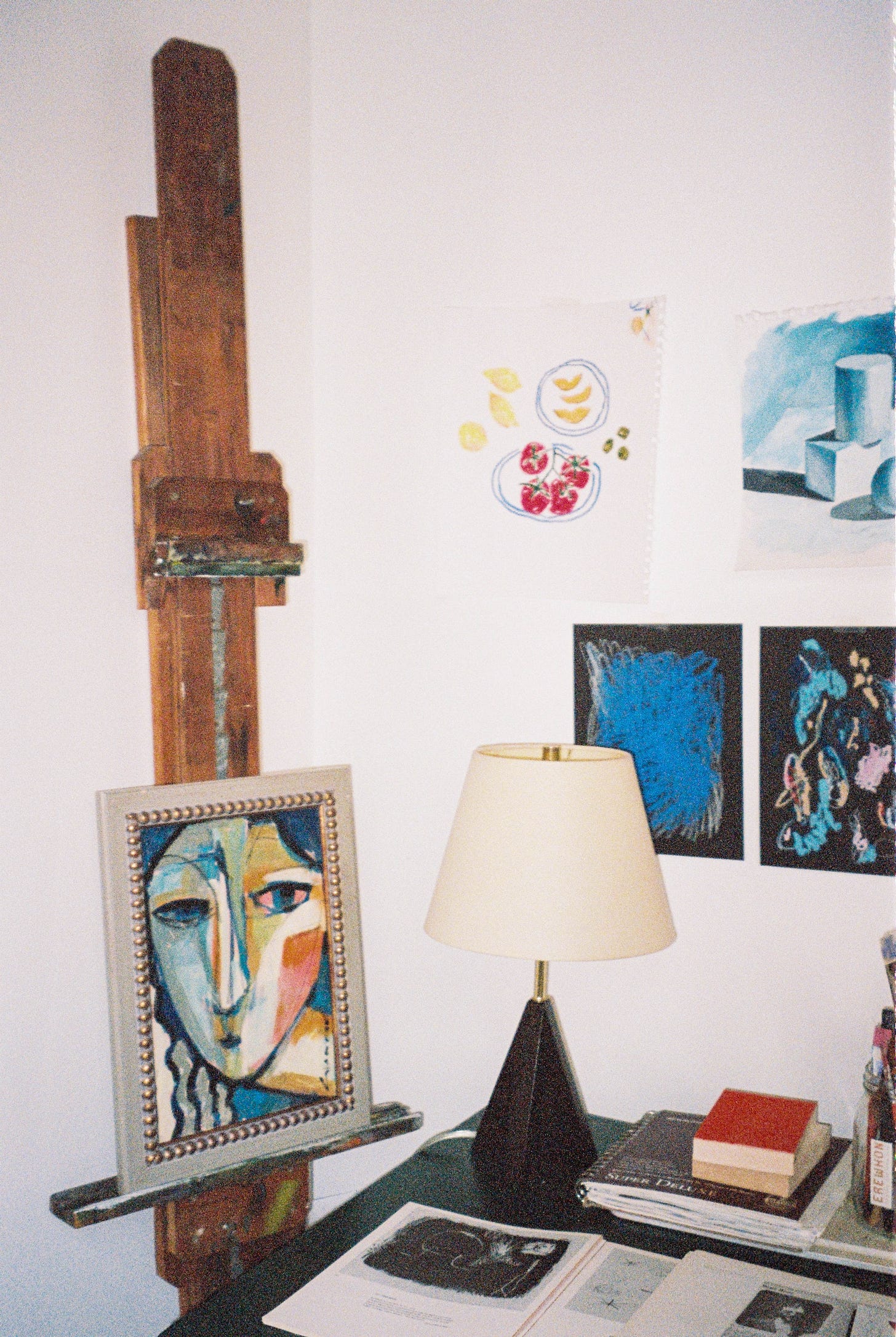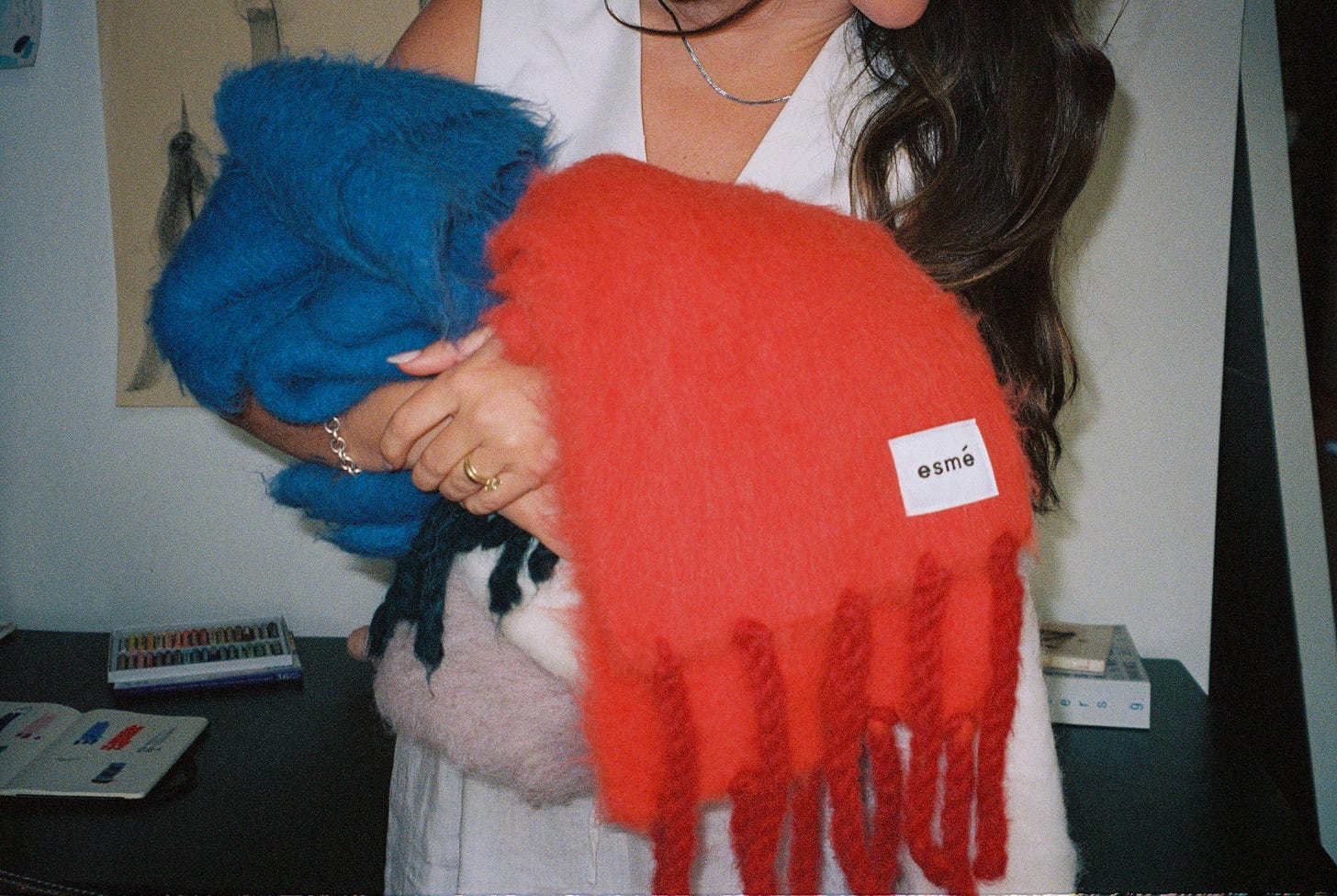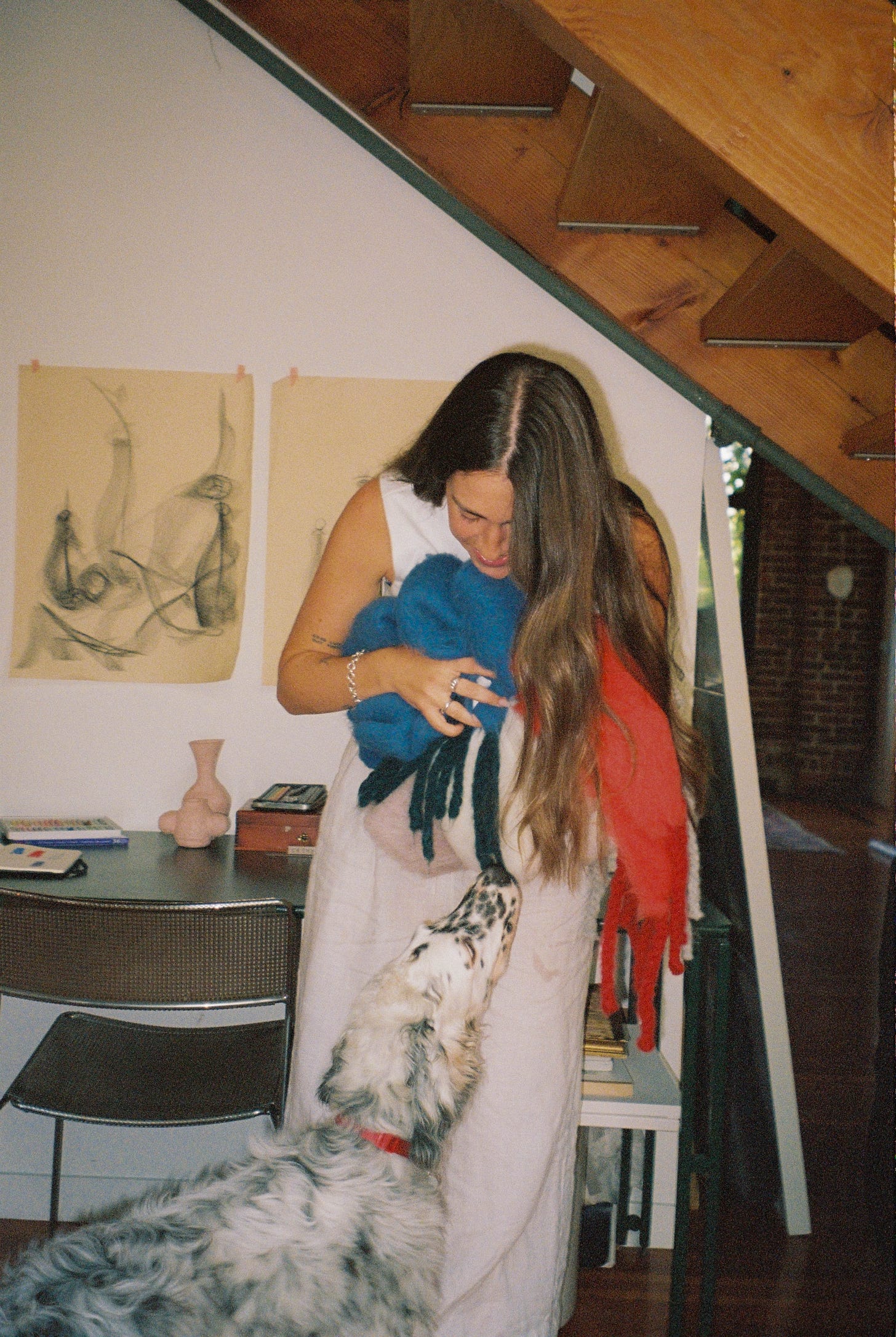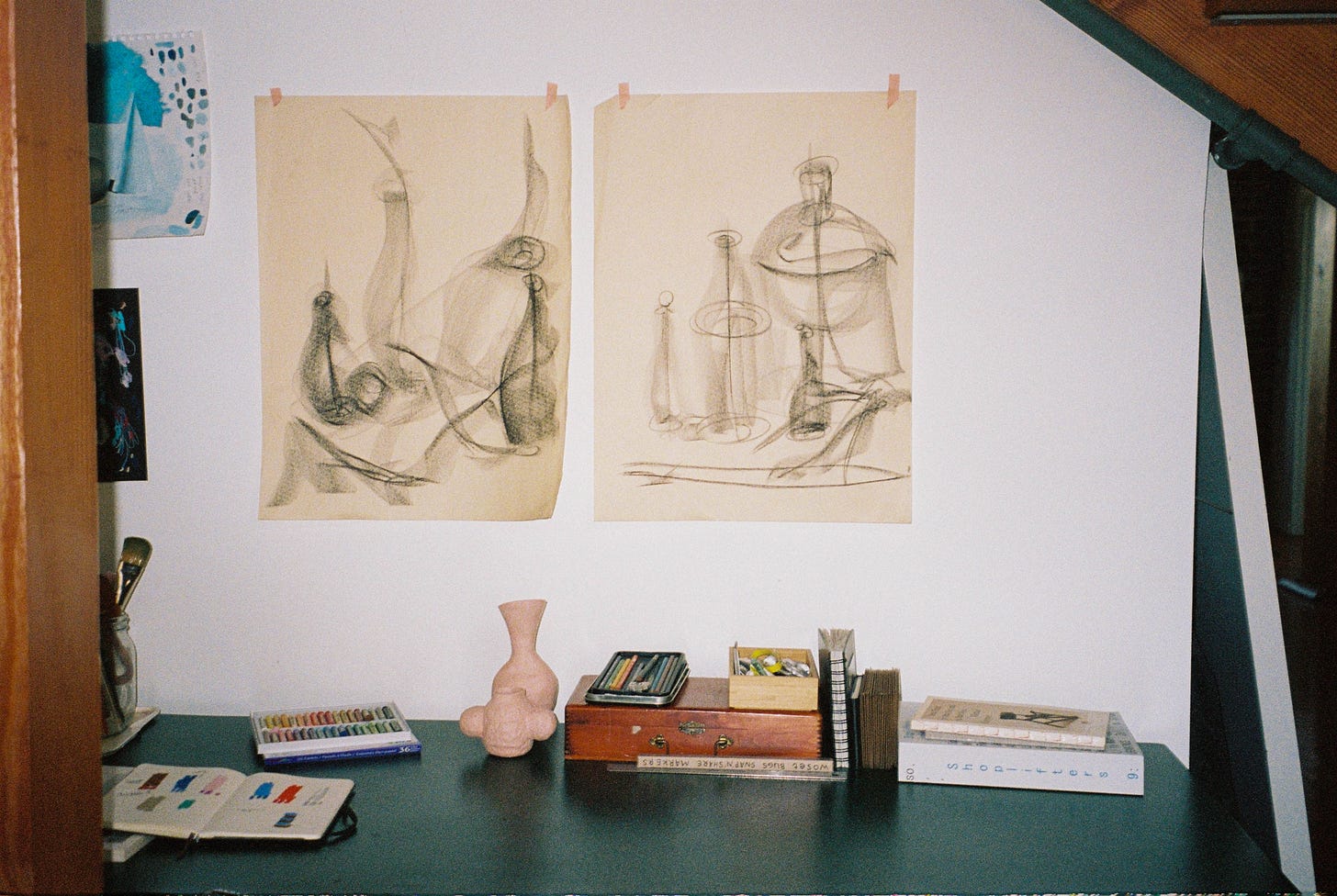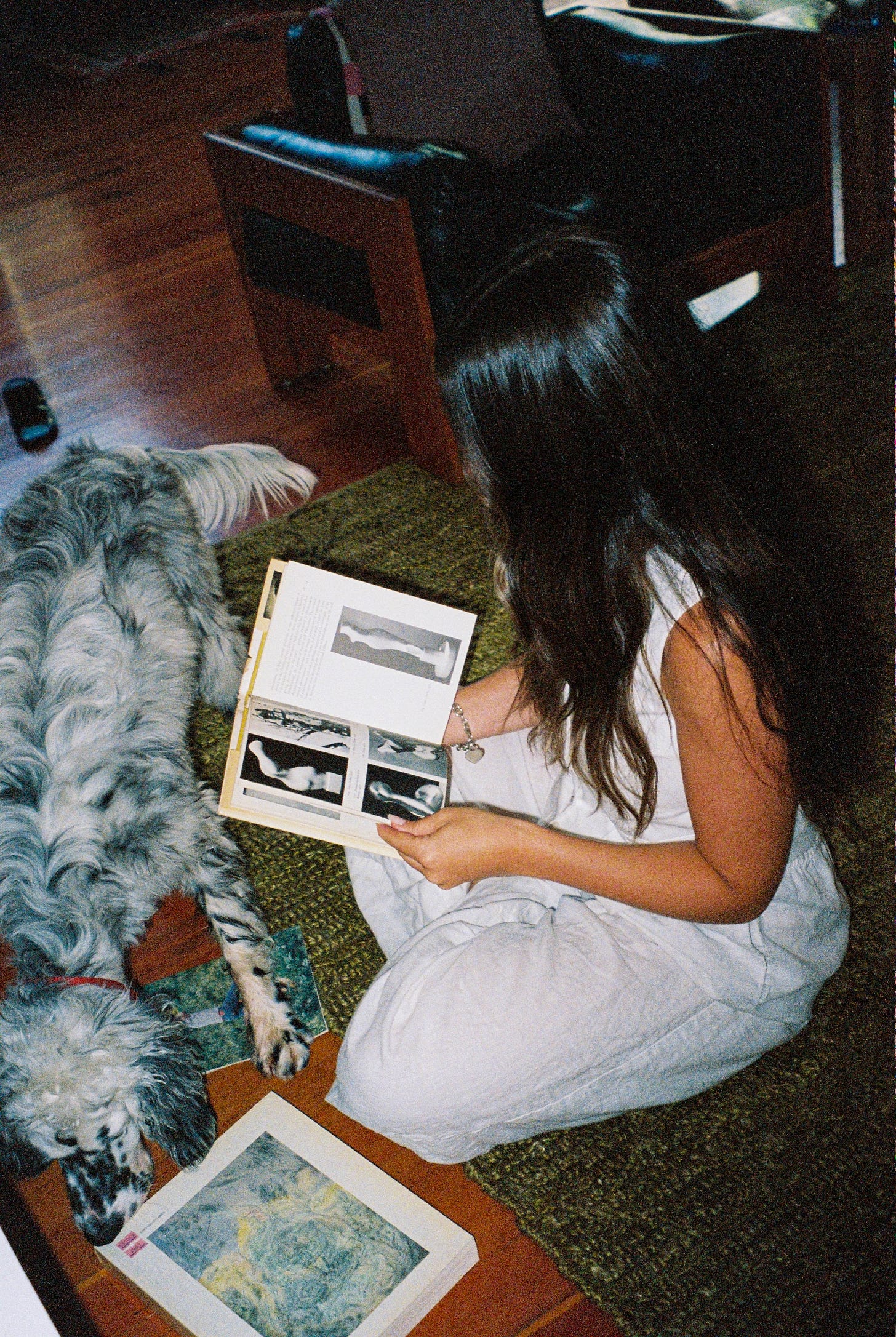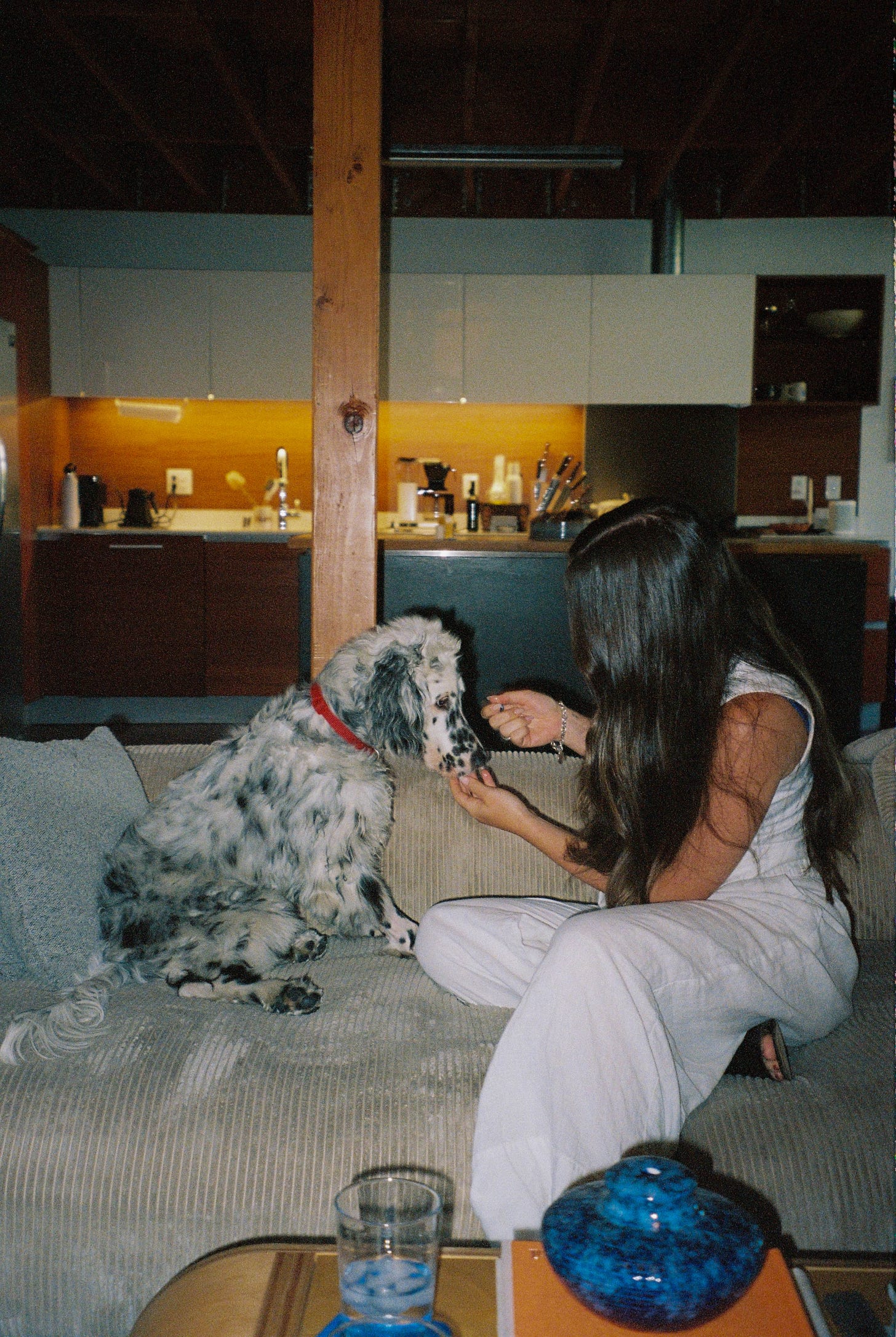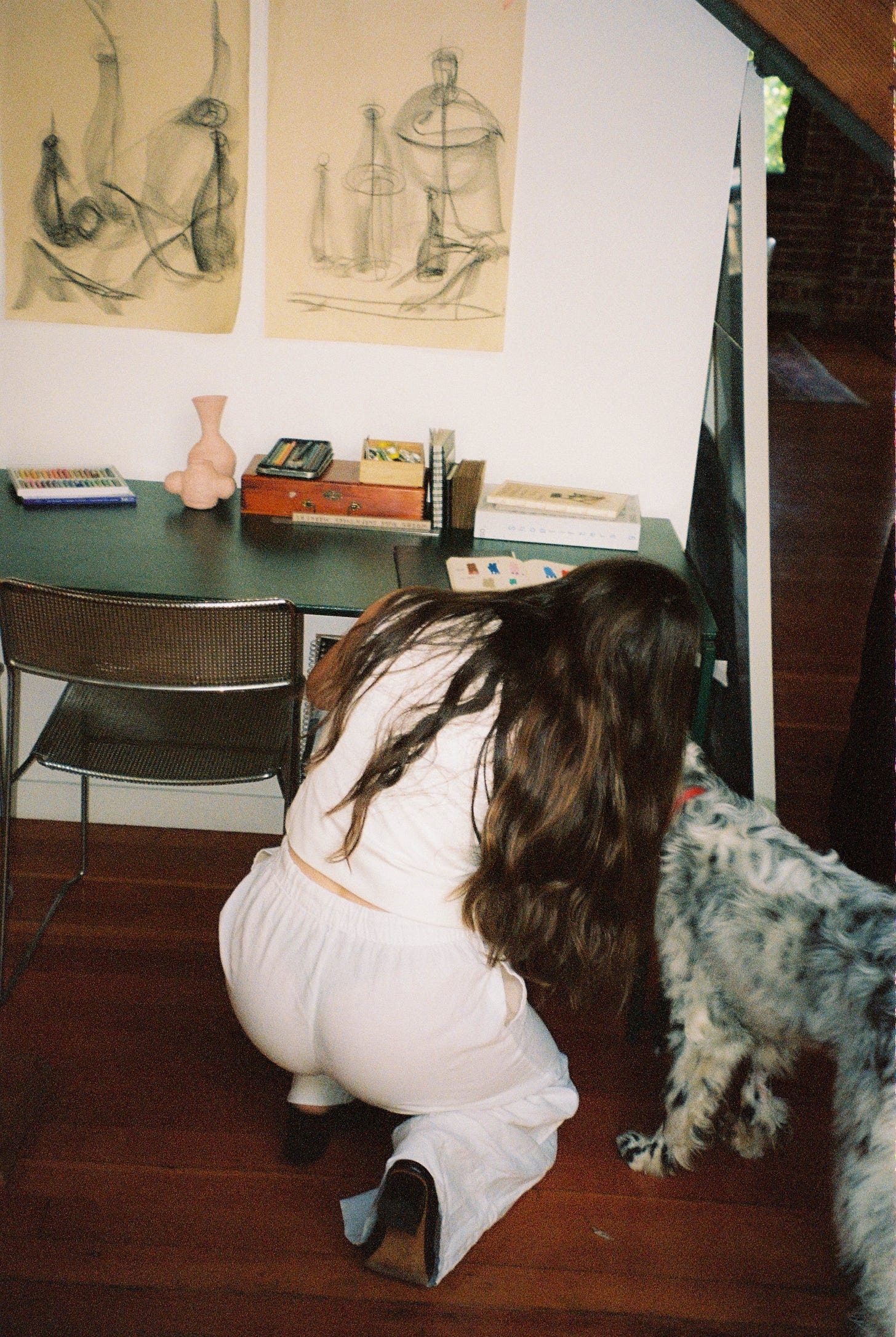Mackenzie Tan has a lot on her plate—Founding partner at creative agency, Mouthwash Studio, designer and founder of Esmé, dog mom to the sweetest english setter puppy, Miro. All of this before turning 30 last week. It’s a lot to juggle. Certainly enough to make even the most professional pro seem a little stressed. But Mackenzie, despite running two companies with a long laundry list of to-do’s, has the demeanor of some sort of incredibly poised and tasteful earth angel. Being around her is sweetly serene, a breath of fresh air from the smog-filled fumes us Angelenos heave in as we run from meeting to set to wine bar to art show back to meeting again. Mackenzie is doing all of that (and then some!) without breaking a sweat plus with a beaming smile too.
I’ve always admired Mackenzie from afar—increasingly impressed with the work and growth from her and her team at Mouthwash. We met years ago when Mouthwash was just launching, and even then, I was in awe of her attitude. Despite being young (fresh out of college and new to LA) and without the many accolades she now currently possesses, Mackenzie had the hunger of a someone excited to get to work with the ease and confidence of someone much more her senior.
She’s older now, though not by much, and has accomplished a whole lot. Yet, there is no pompous ego, no coasting on the sidelines even though she’s met many of her goals. Instead, there’s an intense passion for building new things and collaborating with as many artists as possible. This past year she launched Esmé, a collection of mohair scarves as cozy as they are beautiful. When I saw Esmé for the first time, it felt inherently from the heart, a Mackenzie Special™️ if you will. Mackenzie is constantly in motion, with many irons in the fire that she continues to strike. She’s not afraid to try something new regardless of the outcome. That fearlessness in her work is something a lot of us could learn from. So I sat down with Mackenzie, in the beautiful home she shares with Mouthwash co-founder and now husband Alex, to absorb a little bit of her wisdom and, of course, enjoy a bit of her contagious calm. 💙
Isadora: Great. So introduce yourself.
M: Hi! I’m Mackenzie, I’m a female designer and creative living in Los Angeles. I’ve lived here for just about six years now. Some parts of me feels like I just got here, but another part of me feels like I've been here forever. I can't imagine leaving.
I: Where are you from originally?
M: Chicago.
I: And what brought you out to LA?
M: A mix of things, but mostly work related. I was in Chicago and working with people who lived in LA when we were trying to start and build what we all run now, Mouthwash Studio. Working remotely was becoming increasingly difficult, leading me to search for job opportunities in Los Angeles. And also Alex, who I wasn't dating at the time, also lived out here and was my best friend, so that was a big reason as well!
I: You started touching on it, but do you want to share a little bit about Mouthwash?
M: Mouthwash Studio is a creative practice that I started with my best friends five years ago. Originally it was a side project that we were working on for fun while we were still working our full time jobs—we started a magazine and a podcast that really was the origin of Mouthwash and gave us our start. About a year or two in, enough project inquiries rolled in to make us realize that it was time to step into the next season of MW.S. We took a leap of faith and quit our jobs. And now, we’re five years in.
I: Nice! Ok let’s backtrack a little. You grew up in Chicago. What were you like as a kid?
M: As a kid, I grew up doing a lot of dance. I was just a silly kid who loved performing, whether in class or in the living room for my parents. I don't think I ever thought I was going to do that forever, but looking back, I see that dance was the earliest sign of creative expression.
I am the middle child with two sisters. We were very close in age with less than three years between all of us. We grew up running around barefoot, playing make-believe and dress up—it was a storybook childhood for a little girl.
I: Very idyllic. When did you start to discover the side of creativity that you are active in now?
M: In high school I was really drawn to the art department, finding myself there during lunch hours and study halls, and squeezing in as many new classes into my schedule as possible. And while these newforms of art-making sparked my interest, photography seemed to have the most lasting impact, leaving me constantly taking photos of my friends and sisters as my test subjects. Heading into college I had wanted to pursue photojournalism, mostly because that was the only job I knew at the time where I could pursue photography as a career. I owe a lot to my guidance counselor at school who challenged me to think outside of that, and mix in some design courses to even out my schedule. At the time I had no idea what graphic design was, but I took her word for it, and after a few classes, there was no turning back.
I: Okay, interesting. I mean I had the exact opposite experience with graphic design, but obviously I'm not a graphic designer. But where did you go to college?
M: I went to a really small private school in the Chicago area called Judson.
I: So you went into college thinking you wanted to be a photojournalist, then you sort of pivoted because you fell in love with graphic design. Once you fell in love with graphic design, did you start having an idea of what what sort of career you might want?
M: The first studio that I worked at after school gave a lot of clarity about my career. While I was technically a designer, I wore many hats, and was asked to assist on productions, giving me experience with set design, art direction, styling, and photography. After a few years, I started working with a new studio that had me focus solely on digital design. I realized then that I was misidentifying my love for photography as a love for crafting a vision and providing direction. I realized I didn't have to be the person behind the camera in order to create something that was beautiful. One of the biggest things I learned was the beauty of getting to collaborate with many different people with different skills and perspectives, which makes for much better work in the end.
I: It sounds like this wasn't an issue for you, but this has been something that a lot of people have brought up in these conversations, especially as it relates to them coming into their own identity as a creative. They bring up how they never knew that the current career that they had was a possibility because they were told so often when they were younger that they couldn't choose a creative path, because it wasn’t the responsible or lucrative choice. Was that something that you ever had to struggle with or not really?
M: Honestly, not really, I feel very fortunate! I had parents who championed anything that I wanted to do. Even wanting to study design without knowing much about it, they always fully supported me following paths that brought me life. Because of them, I always believed I could make something out of whatever I was doing, which has carried me a long way. Even now, there are so many things I pursue that I jump into without fully thinking about ‘is this going to be super successful’? I think if you have a passion for something and it’s life-giving for you, it’s worth pursuing in one way or another, if that makes sense.
I: It does. I think it's interesting though, I do think for a lot of people who maybe have been told that they can’t choose a creative path, there's this element of paralysis around pursuing what they love and then they get to it maybe at a later age, but it's this huge unlock for them. Okay, so you're in college, you realize you love graphic design, you go through the motions of graduating. Then what?
M: I graduated from school and shortly after moved to the city in Chicago where I accepted a job at a design agency. That's where I really shifted from the production world to a digital agency and working on design. It was a fairly small studio, so I was immediately put in a position where I was presenting to clients, coming up with ideas, and leading projects. In hindsight, I did not have the experience or credentials to be able to do that, which was scary, but at the same time, it gave me a lot of confidence as a new designer. I think being put in the position to rise to the occasion gave me no choice but to jump in head first. I worked in that studio for a few years before I started to consider the move to Los Angeles. We were already starting Mouthwash magazine at the time, but that's all it was— a magazine and a podcast where we interviewed creatives in the industry that we looked up to. After much deliberation, I packed my bags and moved out here. Six months later, we quit our jobs to do Mouthwash full-time.
I: Going back a bit, since you were in Chicago and everyone else who was a part of mouthwash was in LA, how did you guys meet?
M: We all met during this very specific era on Instagram where everyone was friends without having ever met in real life.
I: Yes, I remember that era well.
M: For years we were just internet friends. Sometimes we look back and there'll be photos that I posted years before we met, that they commented on. Alex and I had met in Chicago before I moved to LA at a creative event where I was presenting some work. Alex and Abraham met when they both moved to LA. It was an interesting time meeting your internet friends in person, because you felt like you knew them so well already.
I: I remember that time very, very well and I have a couple of friends like that, but it doesn't exist like that at all anymore and I don't think it ever really can again. So it's kind of special.
M: It was so special.
I: Okay, so you move out here and you start Mouthwash Studio. When you guys first started, what was the original vision for Mouthwash?
M: In the beginning when we were focused on the podcast and magazine, we always knew we wanted to create a studio together eventually. Alex and Abraham were also both photographers and art directors at the time, but we knew that was only one piece of what we wanted to do. The vision was 1. Just survive and 2. Figure out how we can get work and make money, but most importantly, make work that we're proud of.
The first year we had a few paying clients, but we also took on a lot of pro bono and passion projects. We’d reach out to artists, creatives, or brands we admired and ask if we could do a website or photo shoot for them, which helped us build our portfolio, so everyone wins. The first year was pedal to the metal: Do all the work we can do, at the best possible quality, work with people we admire, and try to build this thing from scratch. It was so hard but it was so, so fun.
I: Yeah, I meant I met you and Alex in San Francisco. You guys came into the Everlane office. I think you maybe had launched mouthwash within the past year. It was still very fresh, but I remember being so impressed. So obviously a lot of this project is about reaching a place in your career where when you were younger you thought that's where you wanted to be and then getting there and being like, this doesn't feel the way I thought it would feel. That's not necessarily the case for everyone, but I'm curious what that's been like for you. Mouthwash has had a lot of success and and I'm sure there's a sense of pride in that, but have there been other feelings for you as well now that you’ve perhaps reached a lot of those original goals?
M: It's interesting having a vision for something and then watching it come to life in ways that you didn't think was possible. We’re now a team of 16 people (and growing) and have people in the UK, Spain, New York, Texas, Portland, and Los Angeles. The team is actually the thing I’m most proud of when I look at Mouthwash Studio in its current form. Turning 30 this year and reflecting on how far we’ve come, there's a sense of confidence, of just trusting yourself that I just didn’t have in my early twenties.. There's so much left for us to do, grow, and learn, but there's also an inner trust of yourself and your decisions that I didn't expect. You learn your craft and you know it, and then you feel confident teaching other people that which has been a fun, surprising element of it all.
A huge part of my personality which has led me to where I am today is a consistent sense of wonder and a constant urge to try something new, which is how Esmé came to be, a scarf and accessory brand that I launched late last year. Before Esmé I had another project called PDA, which was a brand my partner and I were working on for a few years, that right now we're kind of putting on pause. For us there’s an excitement in new challenges and trying new things, even if they are small and personal.
I: Are those things different than what you set out to do with Mouthwash?
M: Lately I’ve been interested in doing things that are offline. There's definitely parts of me that questions sitting behind a computer all day and that part feels very draining, but I think building a team with amazing humans who are extremely talented has helped counteract that.
I: You said something earlier that I want to come back to—that you start things because you want to start things without thinking about whether or not they'll be successful. It’s a unique and special perspective that a lot of folks don’t have. I'm curious, and I think a lot of people would be curious how you do that? There are so many pressures of defining yourself as an artist and what that means and wanting people to love your work, but also wanting it to have a perspective. How do you do quiet those fears and just do it / start it anyway?
M: I think my perspective on these side projects is seeing them more of a creative expression versus a business when starting out. It’s never been about making a ton of money selling scarves, it's always been about making an extremely high quality product, outputting the best creative possible and expressing it in a way that feels genuine. It's removing the pressure of it having to be this crazy successful thing and view it more as an experiment that can change and can be redefined as we go. It’s freeing to think about how I can release Esmé as scarfs, but then if in a year I don't want to make scarfs anymore and I want it to be socks, that's okay too.
I: For some people there's the element of a livelihood or making money if you are going about it as a business. But then on the other side, there are people who are interested in a thing that they've never done before or haven't really had the opportunity to express it creatively because of whatever—their upbringing, et cetera. But then I find with a lot of artists in particular, the fear is more around what other people think. Have you ever struggled with that?
M: I feel like as an artist, or honestly as a human, everyone struggles with that to an extent. Using our previous project, PDA, as an example, we did a few collections in a row and then with things picking up at MW.S, we had to stop for a while and lost quite a bit of momentum. It was definitely hard for us to make the decision to put it down for the moment, even though we had absolutely no capacity to see it through, because it felt like a failure. But at the end of the day that’s what was best for us in every regard, and gave us some valuable headspace back.
I: It's this balance of having a lot of irons in the fire and then striking the iron that's hot. You can always go back to the other irons, but allowing yourself to play and then when one seems to really be resonating, grabbing onto that one. Okay! I do want to talk about Esmé because but it feels like a Mackenzie Special™️. It feels very through the lens of you. And so I want to hear a little bit about how it sort of came to be.
M: The name itself is really special to me because it comes from my grandpa. When we were little, he gave me and my sisters these silly nicknames for absolutely no reason at all—his name for me was Esmeralda. And we call him Grandpa Coyote—I have no idea why. We had a really special relationship and were pen pals for many years. He lives in California and we always lived in Chicago, so the letters were a fun way for us to keep in touch. Over many years of me studying abroad in Rome, to me doing an internship in Montreal, he always wrote to me, and it was always addressed to Esmeralda. So when I was thinking about making these mohair scarves, I wanted them to be really soft and cozy and wrap around you. It felt right to name it Esmé, because it feels like a sweet hug from someone you love, or reading a letter from your grandpa who’s halfway around the world.
I: I love that so much. It’s so tender.
M: Esmé has been so refreshing to work on, it’s felt so offline in the best way.
I: Do you have a vision for other physical objects you want to make through the lens of Esmé?
M: We’re currently working through that actually! Definitely more colorways and variations of our signature scarf to start. But we’re thinking about expanding that as well—things like hats, mittens, and socks all sound fun to me. We also have some interest in exploring some home items like throw blankets or pillows. Moving into this loft that I love has motivated me to think more about what's in my home and create a space that I feel inspired in.
I: I'm a sucker for mohair, so I love the throw blanket idea. Okay. I've been asking this question to a lot of people because I think it's really interesting to hear everyone's answers, how do you get validation?
M: I think for Esmé, if someone's wearing it, that's the biggest compliment. I had a friend order three—one for herself, one for her mom, and one for a friend. I love that! I've run into a few people just in LA this past winter wearing it, and it surprises me every time. I love seeing how people style it, how they capture themselves wearing it, and seeing how it becomes a fun way to accessorize their wardrobe.
I: I think there's also probably something validating in just launching something even before you really see what comes of it. It feels good to work on something, put all this energy into it, and then actually have it out in the world for people to consume or look at or buy, which you've obviously done in a variety of different ways now. Another question that I ask everyone, because it is sort of the sole purpose of this project, are there people or brands or places or things that they are huge sources of inspiration to you?
M: We're so lucky to live in LA where your neighbor is probably an amazing artist or actress or woodworker or building something incredible, I find it incredibly energizing. One of our favorite things about living in LA is finding ways to work on projects with people we admire who are masters in their craft, the better it's going to be.
I: Yeah, hundred percent agree. What are parts of your own practice or ritual that makes you feel creative that don’t have anything to do with your career?
M: Definitely books! We just have a growing book collection, and my favorite thing is to go to the Rose Bowl or look online for vintage books that inspire me, regardless of the subject. I find so many new artists that way, which informs research for new projects. I find sculptors specifically so inspiring, I love studying the way they work and the way they express ideas through physical form. I do a lot of visual research online as well, but my favorite is actually sitting down and looking through the pages of a book.
Getting offline is also very inspiring to me—traveling, going on hikes, taking ceramics classes, cooking—all of these things make me feel creative and re-energized. I think as I've gotten older as well, I've found that I’m at my healthiest when I have that right balance of work and play. There's obviously so much more time that I want to dedicate to making art, and everyone’s dream is to quit their job and go make art (and maybe I'll do that one day) but just finding ways to inch closer to that balance every day.
I: It's funny too, it's sort of a 180 in that you kind of started a lot of your creative work life through relationships online, and you respect that and glad that had happened, but now you're trying to inch your way a little bit off the internet.
M: Yeah that’s so funny to think about. Even something as fleeting as my Instagram profile gave me an existential crisis the other day. I was looking at it from the perspective of someone who didn’t know anything about me. For a long time on Instagram I didn’t really post anything about me or my personal life, and only posted work, which didn’t feel representative of the whole of who I am (leading me to dramatically archive half my profile, as one does). The internet is an interesting place and a lot of my career did start there—that's where I met my business partners, my now husband, and where I continually share new projects with the world. It definitely is this tug of trying to get off of it, but also needing it as a tool.
I: It's a weird thing. We're all constantly creative directing our internet personas, but in a way, from almost a positive perspective, a lot of people I've talked to, and you've sort of hinted at this too, this idea of if you are making art and you're consistently just doing it and making it, putting it out there, there's a world where two years from now you look back at something you made and you're like, I hate this, but that's okay. And you're like, it doesn't really matter. Because that's the point. I'm constantly working on this thing but it’s also constantly shifting, I'm shifting, I'm changing. My work is changing. So theoretically, one could also apply that to your Instagram profile!
M: Always changing. Always evolving!
I: Alright, now let’s take some photos.






